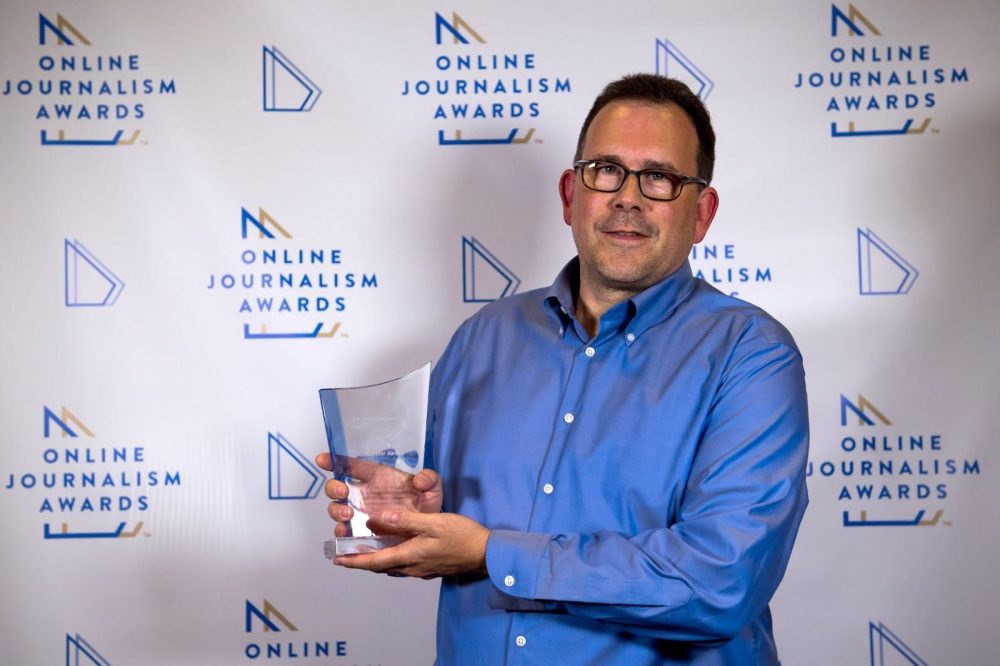
News @ Knight – Looking forward to digital journalism’s high school reunion
ONA22 kicks off next Wednesday in Los Angeles.

I attended my first Online News Association conference in 2004. I had just been hired as executive editor of washingtonpost.com and was eager to learn more about this new organization that was getting some good buzz.
Little did I know how much of a part of my life and career ONA would become.
I have not missed an ONA conference since that first one. I joined its board in 2005 and served for a decade, becoming ONA’s president in 2012 and 2013. And one of my most cherished career memories was winning ONA’s Rich Jaroslovsky Founder Award in 2017.
My first ONA conference was in Los Angeles. So it’s fitting that my first ONA as Knight’s vice president of journalism will also be in the City of Angels, starting next Wednesday.
When I joined ONA’s board in 2005, the organization had a staff of one and much of its operational work was still handled by the board. But thanks to expanding support from funders – including Knight, which made its first of 19 grants to ONA in 2000 – the organization was able to steadily grow staff and greatly expand its range of services. The first ONA conference in 1999 had around 100 attendees; conference attendance now counts in the thousands. Outside of never being able to wrestle away ONA.org from the Ontario Nurses’ Association (but journalists.org ain’t bad), ONA has had quite a run of success.
And for those of us who have been in the digital journalism game for decades, the ONA conference is more than just a place to learn. It’s a digital journalism high school reunion of sorts; a chance to catch up with hundreds of friends and colleagues.
Knight’s entire journalism team will be in Los Angeles – including one new team member – and we’re looking forward to catching up with so many friends and colleagues. Knight will have dedicated space at the conference – the Mount Washington Room on the 2nd floor of the Westin Bonaventure Hotel & Suites – so feel free to come on by for breakfast on Thursday, Friday or Saturday.
This will also be a bittersweet ONA for some of us, as it will be the last for ONA CEO Irving Washington. I’m proud to have been on the committee that recommended hiring Irving for his position in 2017, and it’s been wonderful to watch him – and learn from him – while he’s served in this position. His warmth, sense of humor and legendary calm demeanor will be missed, and, like many, I’m eager to see what Irving does next. Congrats on a job more than well done, Irving.
Other news around the horn…
Policy
🌴 California goes big with $25 million for local news. People cheered when New Jersey passed a landmark law to support local news in 2018, eventually handing out $500,000 per year in grants. Now they will lose their minds after California upped the ante with $25 million to support a new local news fellowship program out of the UC Berkeley Graduate School of Journalism. Inspired by Report for America and a similar fellowship program in New Mexico, the California legislature approved funding to support 40 journalism graduates in the state who will be placed in newsrooms in underserved areas of the state. Fellows and their newsrooms will be selected by an independent advisory board, and each Fellow will receive $50,000 per year over three years.
Awards
🏆 Roll out the red carpet; it’s award season! They might not have catchy names like the Emmys or the Oscars (however, props to “the INNYs”), but news awards are kicking it into high gear. Here are some early huzzahs:
- The Local Media Association (LMA) announced that Maritza Félix of Conecta Arizona won the Innovator of the Year Award for news and audience. During the pandemic she noticed that the Spanish-speaking community was spreading misinformation on social media, so she launched a service on WhatsApp and Facebook to counter that with trusted information.
- The Online Journalism Awards (OJAs) announced 165 finalists ahead of next week’s awards show at the ONA Conference in Los Angeles. The Impact Award has already been given to S. Mitra Kalita for her work as a trailblazer, launching Epicenter-NYC and URL Media during the pandemic and being a mentor to so many journalists of color.
- Yes, the INNYs, or Nonprofit News Awards from INN, will also be announced at ONA on Sept. 21, and the finalists have already been named. Kudos to Emerging Leader finalists Christopher Baxter at Spotlight PA, Kimberly Griffin at Mississippi Free Press and Ryan Sorrell at the Kansas City Defender.
Impact
✨ Product-thinking pays off. Working in a “product” role at a newsroom means helping to align business, audience and technology goals alongside journalism ethics, according to the News Product Alliance (NPA). One problem? “Some of our community members were actually doing product work without knowing they were doing product work,” NPA executive director Feli Carrique told Nieman Lab. But the NPA is changing that with its 1,400+ global members, fantastic training programs run through CUNY, a growing Summit event, and a Slack channel that helps people network and receive advice. In fact, of the almost 200 Summit attendees that had a job title or job change toward product work, 70% said the NPA had an impact on their career shifts. Plus, there’s a newly launched Network Mentor Program.
⛪ Salt Lake Tribune scores national success with Mormon Land. Speaking of great product ideas, the nonprofit Salt Lake Tribune realized its ongoing coverage of the Mormon church would spark interest from folks outside the geographic area. While they might not subscribe to the Tribune as a whole, they might subscribe to the existing “Mormon Land” newsletter and podcast. So they teamed the editorial folks with marketing and audience team members to launch a Patreon offering with three tiers of support. In a deep Better News report, the Tribune explains how it created a new recurring revenue stream that has already paid for the religion reporter’s trip to the Middle East.
Research
🗞️ Gen Z, Millennials consume news but don’t enjoy it. Then again, who does? A survey from the American Press Institute of Americans ages 16 to 40 found that 79% get news daily, and nearly a third were willing to pay for it (the older they are, the more willing to pay). But just 32% said they found the news enjoyable, down from 57% seven years ago, with many saying they limit their time online. Trust in national news and social media is low, but trust in local news is better. Plus, nearly half say coverage of communities of color is slightly or totally inaccurate. And 90% feel misinformation is a problem, with 70% saying they were victims of it, yet they are as likely to blame the media as politicians or social media.
🔔 How local news misses the mark in Philly. Even the relatively robust news ecosystem in Philadelphia still has a problem serving important information into lower income, lower educated communities, according to a new study in the Journal of Communication. The researchers found that there’s a “measurable gap in the provision of news content meeting the critical information needs of these communities.” Plus they found “digital news deserts” where online-only outlets still aimed to reach affluent audiences and didn’t have the resources to better cover less affluent communities. “These findings may not be all that surprising—and yet they provide important empirical weight to arguments that there are concerning inequalities in news provision that need attention,” observe journalism researchers Mark Coddington and Seth Lewis.
Upcoming Events 📅
Everywhere
Sept. 15
Online News Association (ONA) Conference
Los Angeles
Sept. 21–24
Boston
Oct. 13–14
Austin
Oct. 27–29
Washington, DC
Oct. 27–30
Tweet of the Week
News @ Knight Credits
Written by Jim Brady, with Mark Glaser
Edited by Jessica Clark and Kara Pickman
Subscribe Here:
Recent Content
-
Journalismarticle ·
-
Journalismarticle ·
-
Journalismarticle ·


